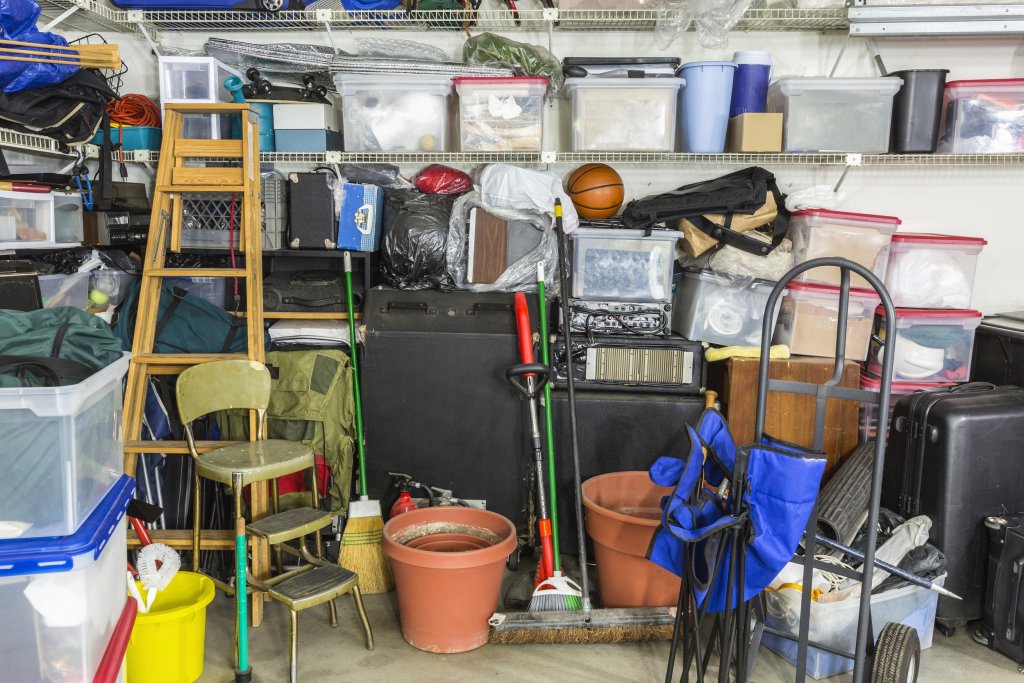Inside: Before you can begin decluttering your home, it’s helpful to know what clutter is. We’ll dive into how to define clutter so that you can start eliminating it.
Chances are, you’ve seen a few headlines and articles about clutter. These articles are filled with tips, tricks, and advice to help you declutter your home and embrace a more minimalist aesthetic, which can be incredibly helpful.
But before you can roll up your sleeves and clear away the clutter, you’ve got to know how to answer the question – What is clutter?
And truthfully, there’s no one-size-fits-all answer. Clutter can look different for everyone. But there are a few common themes that tie that clutter together and make it, well, clutter.
If you’re looking to understand what’s become clutter in your home and what needs to go, I’ve got you covered. Keep reading to learn how to identify the clutter that’s filling your space, distracting your mind, and weighing you down.

Defining What Is Clutter – Why Should We Care?
“Do I really care about what counts as clutter?”
The answer to that question should be a resounding “Yes!”
Everyone has a different level of tolerance for clutter. Some of us can’t stand spending time in a space where things aren’t exactly where they belong, or spaces filled to the brim with random things that don’t have any use. Others have a much higher tolerance for that kind of chaos – to the point where they’ll even say, “Clutter doesn’t bother me!”
But whether or not you can see it, clutter negatively impacts you and can take a real toll on your physical and mental well-being.
Clutter is a huge culprit when it comes to dust and dirt gathering in your home. If your shelves are covered in stuff you haven’t touched in who-knows-how-long, chances are it’s pretty dusty.
That dust gets stirred by the movement of the air in your space – when you pass through a room, or when you turn on your ceiling fan. And in turn, that dust can cause allergies, make your cold that much more unbearable, and more.
Mentally, being in the physical presence of clutter can make it difficult to focus. It can stifle your creativity, make you feel overwhelmed, and raise your anxiety levels – consciously or subconsciously.
By living with clutter, you’re keeping yourself from enjoying the benefits of having a decluttered space.
You can experience those benefits once you understand what is clutter and then take the necessary steps to get that clutter out of your home and where it belongs – the trash, a donation facility, or in someone else’s hands.

How to Determine What Is Clutter and What’s Worth Keeping
Before you roll up your sleeves and begin the process of decluttering your space, it’s important to have a clear understanding of what your clutter actually is – otherwise, you run the risk of going overboard and getting rid of stuff you’re going to regret.
It’s helpful to remember that different people have different definitions for clutter. What’s clutter to one may not be clutter to another.
But there are some helpful guidelines you can use to define what clutter is – and what’s worth keeping.
Broken Stuff = Clutter
Let’s start with the easy stuff. If it’s broken, and you can’t – or won’t – fix it, it’s clutter.
Broken stuff serves no purpose. This is especially true for broken stuff you’re holding onto despite the fact that you’ve already replaced it.
That old TV that won’t turn on, the microwave that randomly stopped working, the broken cell phone in your junk drawer that you might need to figure out how to fix one day, your kid’s toys that just don’t work anymore, that shirt you love but haven’t worn in years because it’s got a big stain on the sleeve…
Be realistic here. When did you last use these items? Do you really love them or use them? If not, they’re simply taking up space, collecting dust, and contributing to your clutter problem.
Figure out the appropriate way to dispose of these things and get them out of your home. You might have to do a little research – for instance, you need to take that old television to an electronics recycling facility, not toss it in the trash.

Things You Never Use and Wouldn’t Miss = Clutter
There are some things you never use but feel the need to keep around for sentimental value – and that’s OK! Most of us have a few family heirlooms, memories from our childhood, and similar items that we can’t stand the thought of parting with because of the sentiment they hold.
But chances are, your home contains some stuff that you never use and wouldn’t actually miss if it was gone. Things like…
- The stack of magazines you flipped through once and no longer need.
- Old clothes stuffed in the corner of your closet or dresser drawers that haven’t seen the light of day in years.
- Craft supplies you bought for that one project that hasn’t been touched in ages.
- Toys and games your kids have outgrown.
- Expired food and spices lurking in the corners of your kitchen pantry.
- The pile of junk mail on the counter that you’ve already sorted through but hasn’t made its way into the recycle bin.
When it comes to stuff like this, the answer is clear – get rid of that clutter and give yourself a little more room to breathe.
Remember, if you don’t love it or use it, it’s clutter. And if your goal is to simplify your space, you’re going to need to let some things go.

Things That Are In the Wrong Space = Clutter
Now, not all clutter is destined for the landfill or local donation center. Some clutter simply needs to be put back in its proper place – at which point, it won’t be considered clutter any longer.
It’s pretty common to have some bad habits that create clutter in your home.
Those books piled haphazardly on your coffee table? Clutter. Put them back on the shelf where they belong, and they’re part of your collection.
Clothes strewn around your bedroom or piled on chairs? Clutter. Fold or hang everything up, and voila! That’s your wardrobe, not clutter.
Toys and board games that seemingly cover every square inch of your floor? Clutter, until you put them back in their proper spot.
By developing decluttering habits in your life and putting things back where they belong, you eliminate clutter and bring order back to your home.

What Isn’t Clutter?
Now that you have a better understanding of what is clutter, let’s spend a moment talking about what isn’t clutter.
There’s a lot of obvious stuff – things you truly need, things you use on a regular basis, and things that serve a meaningful purpose in your home.
But there’s a lot of stuff that doesn’t fall into any of those categories that isn’t necessarily clutter, either. While most clutter doesn’t serve a real purpose in your home, not everything has to serve a purpose.
Things like sentimental keepsakes and family heirlooms can become clutter if they’re kept in a disorganized way and have become burdensome. By putting these things where they belong or storing them properly, you can resolve that issue without having to toss them to the curb.
However if you feel that you have too many family heirlooms or they are causing you more burden than joy, consider which ones you could let go of to lighten your load. Feel free to take a picture before letting them item go if you’d like.
If something makes you happy and adds value in some way, that’s a fair argument for keeping it around. You just have to find the right place for it to go and keep it there when you aren’t using it.
Somtimes it’s easy to assume that no items in a particular category could be considered clutter. Be willing to challenge your assumptions so that you don’t end up keeping more than you’re comfortable with.
One further complicating factor is if you and your partner don’t agree on what clutter is or if they have no interest in decluttering at all. Communication and compromise are key to finding a balance that will work for both of you.

Still not sure what clutter is?
If you’re still having trouble deciding which items you love and use and which have become clutter, check out this post on decluttering questions.
Use the questions that resonate most with you to help you decide what stays and what goes. Answering these questions will help provide clarity as you declutter your home.
Now what? The next step in the decluttering process.
Now that you’re able to more clearly define what clutter is in your home, you can start the decluttering process.
It’s helpful to complete some easy areas in your home to help you jumpstart the process before methodically working through your space. Fill out the form below to get the free jumpstart with a list of places and ideas to help you get started.
How do you define clutter in your home? Leave a comment and let me know!
Sign up on the form below to get weekly decluttering tips sent straight to your inbox. You’ll also get the free Your Home Decluttered Jumpstart which includes 100 easy items to declutter and 12 high-impact areas to declutter in 10 minutes.


right now it all feels like clutter and so disorganized with 3 5 and under and moving 16 hours away…we have been in construction for so long it just feels chaotic 🤦